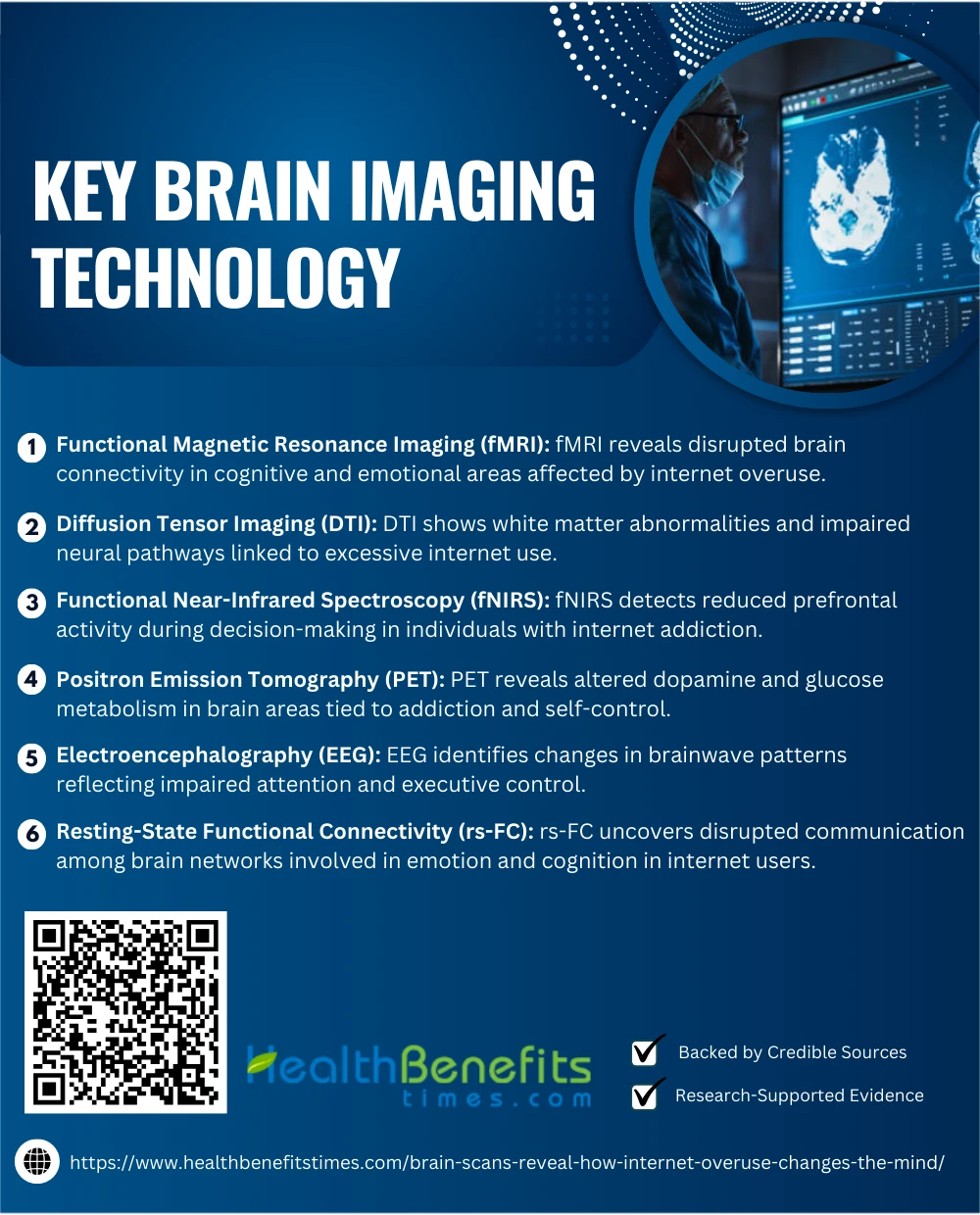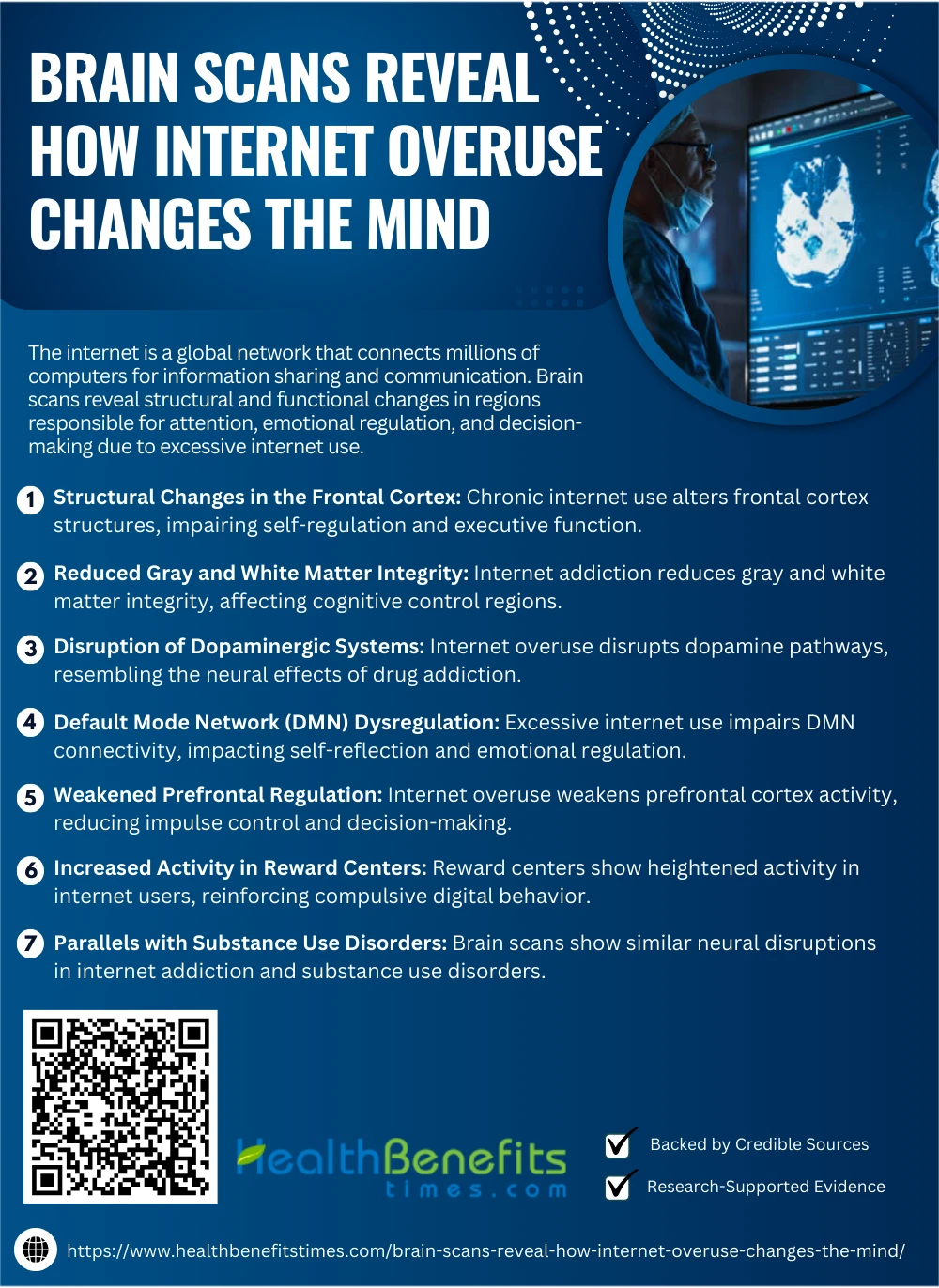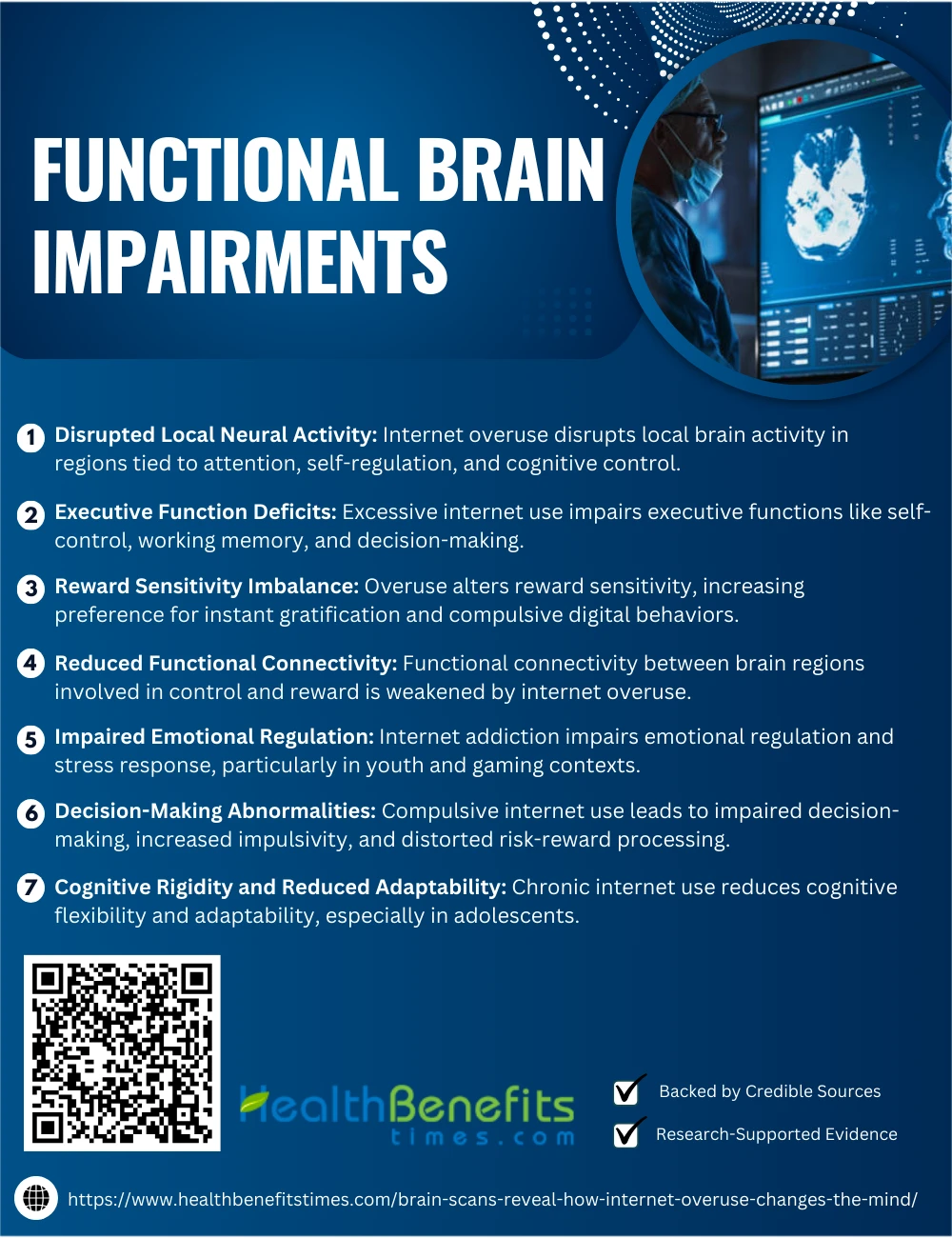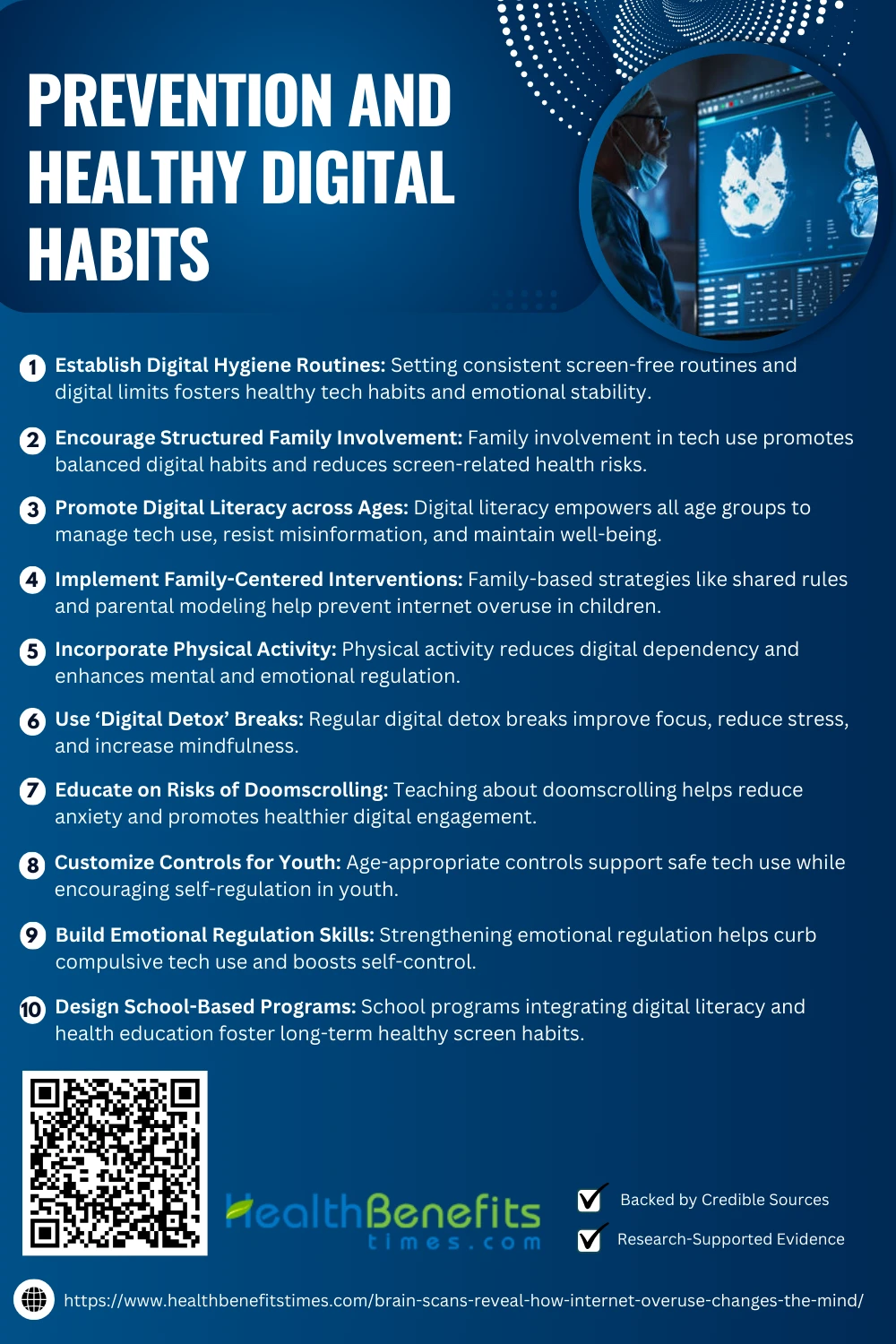- The internet is a global network that connects millions of computers for information sharing and communication.
- Brain scans reveal structural and functional changes in regions responsible for attention, emotional regulation, and decision-making due to excessive internet use.
- Long-term overuse alters neuroplasticity, leading to impaired cognitive control and reduced connectivity in key brain circuits.
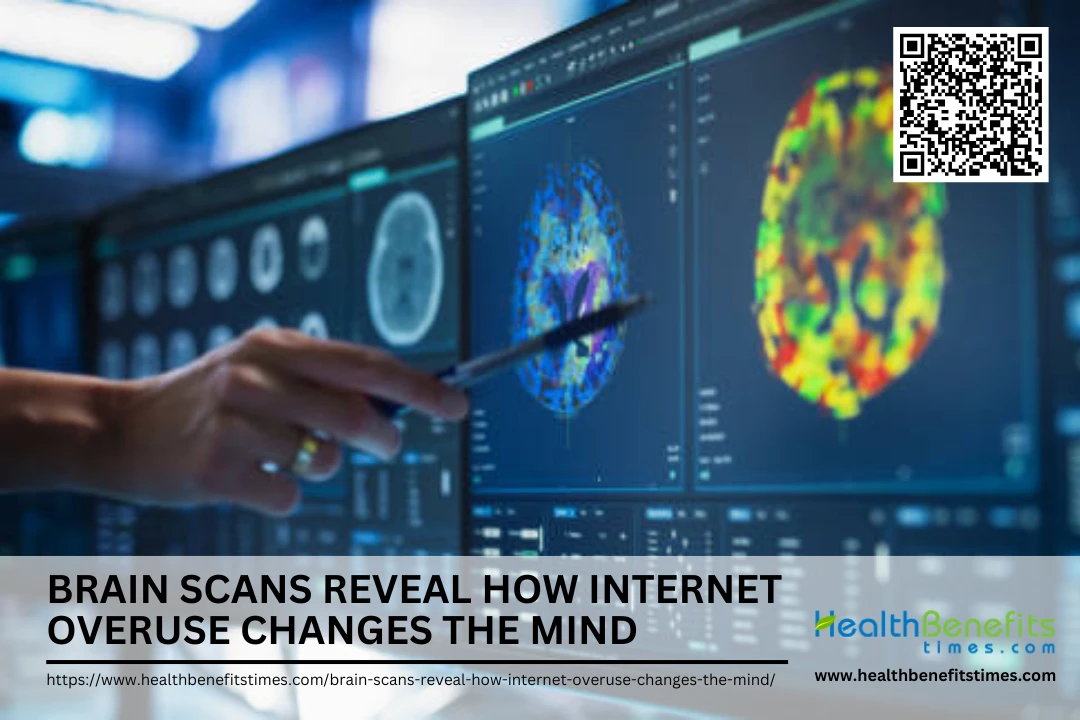 The internet is a global network of interconnected computers that enables the rapid exchange of information, communication, and services across the globe—transforming how societies function and individuals interact with the world. As its integration into daily life intensifies, researchers are increasingly examining the cognitive and neural implications of excessive usage. Recent studies using neuroimaging techniques such as fMRI and DTI reveal that chronic overuse of the internet may lead to measurable changes in brain structure and function, particularly affecting areas involved in emotion regulation, decision-making, and impulse control Neuroimaging insights into internet overuse. These alterations are often seen in the prefrontal cortex and white matter tracts, suggesting that digital addiction could share neurobiological characteristics with substance dependencies Biological parallels with media overuse in children. Understanding how these digital habits reshape our neural architecture is vital for framing healthier digital environments and interventions.
The internet is a global network of interconnected computers that enables the rapid exchange of information, communication, and services across the globe—transforming how societies function and individuals interact with the world. As its integration into daily life intensifies, researchers are increasingly examining the cognitive and neural implications of excessive usage. Recent studies using neuroimaging techniques such as fMRI and DTI reveal that chronic overuse of the internet may lead to measurable changes in brain structure and function, particularly affecting areas involved in emotion regulation, decision-making, and impulse control Neuroimaging insights into internet overuse. These alterations are often seen in the prefrontal cortex and white matter tracts, suggesting that digital addiction could share neurobiological characteristics with substance dependencies Biological parallels with media overuse in children. Understanding how these digital habits reshape our neural architecture is vital for framing healthier digital environments and interventions.
Understanding Internet Overuse
Internet overuse, often termed Internet Addiction Disorder (IAD), is a behavioral condition characterized by excessive or poorly controlled urges to use the internet, leading to distress or functional impairment in daily life Behavior and Psychology of Internet Addiction. (1) While diagnostic criteria remain debated, models often reference compulsive use, withdrawal symptoms, tolerance, and neglect of real-life responsibilities Treatment and Prevention in Adolescents. Clinical assessments may integrate guidelines from the DSM-5 and ICD-11, especially regarding internet gaming disorder as a subtype Online Harassment and Criteria Definitions. (2)
At-risk populations include adolescents, college students, and individuals with co-occurring mental health conditions Prevalence in Nursing Students. (3) Youth from technologically dense environments are particularly susceptible Child & Adolescent Impact, and social-emotional vulnerabilities heighten digital dependency Emerging Adulthood Risk Factors. (4) (5) Early identification and digital literacy are essential in reducing risks.
Key Brain Imaging Technology
Brain imaging technology like fMRI, EEG, and DTI allows scientists to visualize how internet overuse affects the brain, revealing structural changes, disrupted connectivity, and altered activity in critical cognitive regions.
1. Functional Magnetic Resonance Imaging (fMRI)
Functional Magnetic Resonance Imaging (fMRI) is a non-invasive tool that maps brain activity by detecting changes in blood oxygenation, offering valuable insights into cognitive and emotional disruptions caused by internet overuse. Studies show altered connectivity in the prefrontal cortex and reward circuitry among affected individuals Shen, 2024, Zhang & Li, 2025, Pettorruso et al., 2025, Rahm et al., 2024, and Franceschi, 2024, affirming fMRI’s critical role in identifying neurofunctional changes linked to internet addiction. (4) (2) (1) (6)
2. Diffusion Tensor Imaging (DTI)
Diffusion Tensor Imaging (DTI) has revealed significant alterations in white matter microstructure among individuals with internet addiction. Abnormalities in connectivity pathways, such as those seen in adolescents, suggest neuroplastic changes due to excessive internet use. (7) Studies link DTI findings to impaired decision-making and reward systems, highlighting similarities with substance use disorders. (8) (9) Other work confirms thalamic disruptions associated with internet gaming. (9) These findings underscore DTI’s value in addiction neuroscience. (10)
3. Functional Near-Infrared Spectroscopy (fNIRS)
Functional Near-Infrared Spectroscopy (fNIRS) is a non-invasive neuroimaging tool increasingly used to assess cortical hemodynamic responses in internet addiction. A recent study demonstrated that fNIRS detected reduced prefrontal cortex activity during decision-making in individuals addicted to short video content, indicating diminished cognitive control. (6) This aligns with earlier findings linking internet overuse to impulsive behavior. fNIRS provides reliable, portable brain monitoring ideal for real-time social context research on digital dependency.
4. Positron Emission Tomography (PET)
Positron Emission Tomography (PET) plays a critical role in assessing altered brain metabolism associated with internet overuse. Studies using PET have shown decreased dopamine transporter availability in internet addicts, mirroring substance dependency. (11) Another PET study observed prefrontal cortex hypometabolism, which is associated with impaired executive control. (12) Evidence also points to reduced glucose metabolism in the orbitofrontal cortex. Functional disruptions revealed via PET overlap with regions involved in compulsive behavior and emotional regulation. (13) (14)
5. Electroencephalography (EEG)
Electroencephalography (EEG) effectively identifies neurophysiological changes linked to internet addiction, particularly reduced theta and increased beta activity during resting states. (15) A 2022 review emphasized alterations in brain oscillatory patterns indicating impaired executive control in addicted individuals. (16) Findings show altered inhibitory control in EEG connectivity and decreased event-related potentials linked to attention regulation. (17) (18) EEG coherence metrics further suggest disrupted integrative brain functioning in excessive internet users. (19)
6. Resting-State Functional Connectivity (rs-FC)
Resting-State Functional Connectivity (rs-FC) analysis enables researchers to detect disruptions in intrinsic brain network communication linked to internet overuse. Studies show reduced connectivity in the default mode network among problematic smartphone users and impaired fronto-parietal regulation. (20) (21) Findings also point to alterations in the salience network, affecting emotional and cognitive regulation. (22) rs-FC techniques further distinguish individuals with heightened social media dependency and support predictive modeling of addictive behaviors. (23) (24)
Key Findings from Brain Scans
Brain scans reveal striking effects of internet overuse, including reduced gray matter, disrupted neural connectivity, and altered reward pathways—changes that mirror patterns seen in substance addiction and impact cognitive function.
1. Structural Changes in the Frontal Cortex
Brain scans reveal that chronic internet overuse leads to structural changes in the frontal cortex, particularly areas responsible for executive function and self-regulation. Reduced cortical thickness in the dorsolateral prefrontal cortex has been linked with poor impulse control. (25) These alterations resemble patterns seen in substance-related disorders. (26) Imaging also shows disrupted frontal circuits affecting goal-directed behavior. (9)
2. Reduced Gray and White Matter Integrity
Multiple imaging studies demonstrate that internet addiction impairs gray and white matter integrity, particularly in adolescents. DTI scans show diminished fractional anisotropy in the orbitofrontal white matter. (7) Significant gray matter volume reductions were found in cognitive control areas such as the anterior cingulate cortex. (27) These neural changes correlate with behavioral dysregulation. (8)
3. Disruption of Dopaminergic Systems
Brain scans reveal that dopaminergic dysfunction plays a central role in internet overuse. PET studies confirm reduced dopamine transporter availability in individuals with Internet Gaming Disorder. (28) These patterns mirror stimulant drug addiction, suggesting shared neurobiological substrates. (29) Neuroimaging also shows “wanting-liking” dissociation in dopaminergic circuits, driving compulsive digital engagement. (30)
4. Default Mode Network (DMN) Dysregulation
The Default Mode Network (DMN), responsible for self-reflection and emotional regulation, shows abnormal activation in excessive internet users. fMRI data confirm disrupted connectivity between DMN and executive control regions in adolescents with problematic internet use. (31) Further, DMN hypoactivity correlates with poor attentional control. (32) Structural shifts within DMN have been linked to addictive traits and emotional dysregulation. (33)
5. Weakened Prefrontal Regulation
Brain scans consistently show that internet overuse impairs prefrontal cortex regulation, reducing the brain’s ability to control impulses and decision-making. fMRI and PET studies confirm decreased activation in the dorsolateral and ventromedial PFC regions. (10) These impairments parallel substance use disorders, and are associated with poor executive functioning and increased impulsivity. (34) (8)
6. Increased Activity in Reward Centers
Internet overuse stimulates hyperactivity in reward centers, particularly the nucleus accumbens and ventral tegmental area, as revealed by neuroimaging. This resembles neural sensitization seen in substance abuse disorders. (35) Such heightened dopaminergic response reinforces compulsive use and craving, especially in response to digital cues. Neurobiological evidence links reward overactivation to addictive behaviors in both gaming and social media usage. (11) (30)
7. Parallels with Substance Use Disorders
Brain imaging has revealed notable overlaps between internet addiction and substance use disorders, particularly in reward processing and executive dysfunction. fMRI studies indicate that both conditions exhibit reduced prefrontal regulation and heightened impulsivity. (36) DTI and PET data show similar disruptions in connectivity within the default mode and salience networks. (37) These patterns reflect shared neurobiological mechanisms. (38)
Functional Brain Impairments
Excessive internet use leads to functional brain impairments, affecting attention, memory, and emotional regulation. These disruptions hinder daily functioning, decision-making, and mental health, reflecting deeper neurological consequences over time.
1. Disrupted Local Neural Activity
Neuroimaging shows disrupted local neural activity in internet overusers, especially within the anterior cingulate cortex, insula, and precuneus, affecting attention and self-regulation. fMRI studies revealed abnormal connectivity in these key cognitive-emotional hubs. (39) Adolescents show altered salience network dynamics. (40) Cortical thinning in gaming addicts supports this disruption. (41) Others confirmed executive-cerebellar decoupling and overall weakened network efficiency. (42) (43)
2. Executive Function Deficits
Functional brain studies consistently show that internet overuse impairs executive functions, particularly inhibitory control, working memory, and decision-making. fMRI scans highlight diminished dorsolateral prefrontal cortex activity during tasks requiring self-control. (10) Adolescents show slower frontal cortex activation. (8) Risky decisions and impulsive tendencies are traced to abnormal PFC-amygdala pathways. (44) Reviews confirm long-term executive network disruption and decision-impairment patterns similar to drug addiction. (45) (46)
3. Reward Sensitivity Imbalance
Internet overuse disrupts reward sensitivity, creating an imbalance that drives compulsive digital behaviors. Neuroimaging shows enhanced ventral striatal activity and diminished loss sensitivity in addicted users. (47) These users prefer immediate digital rewards over long-term gains. (48) Brain scans reveal abnormal activation in the caudate and orbitofrontal cortex. (37) Structural deficits in reward pathways have also been observed in females, and an overall dopamine imbalance was confirmed through PET studies. (10) (49)
4. Reduced Functional Connectivity
Internet overuse disrupts the brain’s network integrity by impairing functional connectivity, particularly in regions linked to executive control and reward processing. Resting-state fMRI scans reveal altered connectivity in individuals with Internet Gaming Disorder. (50) Theta burst stimulation studies show reduced connectivity in treatment-resistant cases. (51) Neuroimaging evidence points to weakened orbitofrontal and dorsolateral prefrontal circuits. (52) Mindfulness-based interventions restore connectivity across default mode and frontoparietal networks. (53) Moreover, dynamic network analyses support these disruptions as consistent biomarkers. (54)
5. Impaired Emotional Regulation
Excessive internet usage is increasingly associated with impaired emotional regulation, primarily due to neuropsychological changes induced by digital overexposure. Research reveals a correlation between technology addiction and deficits in affective control and stress response systems, particularly within Internet Gaming Disorder contexts. (55) A comprehensive review emphasizes emotional dysregulation stemming from disrupted cognitive networks. (56) Neurophysiological studies also show significant alterations in executive function due to internet overuse. (57) Moreover, gender-specific impacts on emotion regulation have been reported among youth populations. (58) Lastly, persistent exposure correlates with maladaptive reward responses affecting mood regulation. (59)
6. Decision-Making Abnormalities
Frequent internet overuse impairs decision-making by altering neural pathways associated with cognitive control and reward processing. Notably, compulsive digital behavior is linked to impulsivity and delayed gratification, as shown in addiction-related brain imaging. (60) Studies on Internet Gaming Disorder indicate reduced white matter in decision-related areas of the brain. (28) Frontiers research further connects overuse to impulsivity and executive dysfunction. (61) Sleep-related studies also confirm impaired cognitive clarity tied to digital overexposure. (62) Additionally, EEG-based assessments reveal anomalies in risk-reward assessment among overusers. (61)
7. Cognitive Rigidity and Reduced Adaptability
Chronic internet overuse contributes to cognitive rigidity by impairing executive functioning and flexibility, particularly among adolescents. Research underscores the role of poor self-regulation and compulsive behaviors in reducing adaptability. (63) EEG studies show maladaptive responses linked with cognitive inflexibility. (57) CBT interventions have proven effective in enhancing flexibility. (64) Structural studies indicate diminished prefrontal activation in affected individuals. (65)
Can the Brain Recover?
Yes, the brain can recover from the negative effects of internet overuse, thanks to its inherent capacity for neuroplasticity. Neural circuits disrupted by excessive screen exposure can reorganize, allowing for cognitive and emotional restoration. (66) Research shows the reversibility of structural changes through sustained behavioral modification and abstinence. (67) Effective interventions like exercise-based programs stimulate prefrontal cortex recovery, while cognitive rehabilitation boosts functional connectivity. (68) (69) Mindfulness training has also proven potent in modulating default mode activity. (70) Even neurochemical restoration is possible via targeted psychotherapeutic approaches. (71)
Prevention and Healthy Digital Habits
Preventing internet overuse starts with building healthy digital habits, like setting screen time limits, taking regular breaks, and prioritizing offline activities to support brain health, focus, and emotional well-being.
1. Establish Digital Hygiene Routines
Establishing consistent digital hygiene routines is key to fostering healthy digital habits in youth. This includes setting fixed screen-free times, prioritizing digital-free zones, and regulating nighttime device use. A study emphasized the benefits of early routine enforcement on children’s sleep and emotional stability. (72) Health researchers recommend integrating digital well-being into daily schedules to prevent dependency. (73) Digital literacy training also enhances tech usage mindfulness. (74)
2. Encourage Structured Family Involvement
Structured family involvement is a powerful buffer against harmful digital behaviors. Co-regulating technology use through family agreements promotes balance and awareness. Parental involvement correlates with reduced screen-related health risks in children. (75) Collaborative routines, such as device-free dinners, strengthen adherence to positive tech habits. (76) Emotional support and consistent guidance from caregivers improve youth digital self-control. (77)
3. Promote Digital Literacy across Ages
Promoting digital literacy across generations enhances resilience to misinformation, overuse, and digital harm. Lifespan education initiatives help individuals critically navigate content and regulate their online behaviors. For seniors, targeted programs improve digital confidence and well-being. (78) Among youth, enhancing eHealth literacy leads to better health choices and digital balance. (79) Adults benefit from literacy-based frameworks promoting online trust and mindful engagement. (80)
4. Implement Family-Centered Interventions
Family-centered interventions play a vital role in shaping healthy digital routines and behaviors. Strategies such as joint tech-use rules, open dialogue, and parental modeling reduce overuse tendencies in children. (81) Families that participate in structured media plans show stronger adherence to screen boundaries. (77) Clinician-led interventions that engage entire families yield more sustainable digital wellness outcomes. (81)
5. Incorporate Physical Activity
Integrating physical activity into daily routines counteracts the sedentary behaviors associated with excessive screen time. Movement-based programs reduce digital dependence while improving mental clarity and self-regulation. A study shows that digital gamification of exercise encourages sustained engagement in youth. (82) Structured school activities also enhance physical literacy among digitally engaged students. (83) Additionally, primary care systems can bridge tech and health behavior change through activity counseling. (84)
6. Use ‘Digital Detox’ Breaks
“Digital detox” breaks are essential to recalibrating tech use and promoting cognitive clarity. Short-term disconnection improves focus, reduces sleep issues, and fosters mindfulness. Studies have found detox programs significantly reduce academic distraction and stress in students. (85) Structured detox activities improve digital awareness and emotional control. (86) These interventions are most effective when combined with mindfulness and social support training. (87)
7. Educate on Risks of Doomscrolling
Educating individuals—especially youth—on the risks of doomscrolling is essential to promoting balanced digital use. Doomscrolling, the compulsive consumption of negative news, has been linked to anxiety, sleep disruption, and cognitive overload. (88) Awareness campaigns in schools reduce overexposure and foster healthy digital patterns. (89) Furthermore, emotional consequences tied to doomscrolling are well-documented in neuroscience literature on digital distress. (90)
8. Customize Controls for Youth
Customizing digital controls for youth encourages autonomy while promoting safe and healthy online behavior. Age-appropriate tech settings help manage exposure to harmful content and enforce boundaries. Parental involvement in tech governance enhances youth self-regulation. (91) Structured online education and behavioral nudges prove effective in shaping youth tech habits. (92) Context-sensitive rules and control systems are key to fostering digital mindfulness. (93)
9. Build Emotional Regulation Skills
Developing emotional regulation skills is essential for mitigating the risks of digital overuse, particularly in youth. Emotional resilience supports better impulse control, reducing compulsive tech behaviors. Neuroscientific studies show that healthy emotional regulation enhances prefrontal cortex activity tied to self-control. (94) Culturally responsive character education fosters mindfulness and empathy in digital spaces. (95) Family-level interventions enhance children’s regulation skills and reduce screen dependency. (96)
10. Design School-Based Programs
School-based programs are critical for instilling healthy digital behaviors early. Integrating screen-time literacy with health and tech education can prevent overuse and promote well-being. One approach used mobile apps to teach children how to balance screen exposure and visual health. (97) Regional school initiatives link digital literacy to broader child health policy. (98) Whole-school promotion programs enhance community engagement and student awareness. (91)
Conclusion
Brain scans have provided undeniable evidence that excessive internet use can alter the brain’s structure and function, affecting areas responsible for decision-making, memory, emotion, and reward. These changes mirror those seen in substance addictions, highlighting the seriousness of digital overuse. However, the brain’s remarkable ability to adapt offers hope for recovery through mindful habits and reduced screen time. Understanding these effects empowers individuals to make healthier choices in their digital lives. As we navigate an increasingly connected world, balancing technology use with real-world engagement is essential for preserving mental well-being and ensuring a healthier future for both brain and body.



